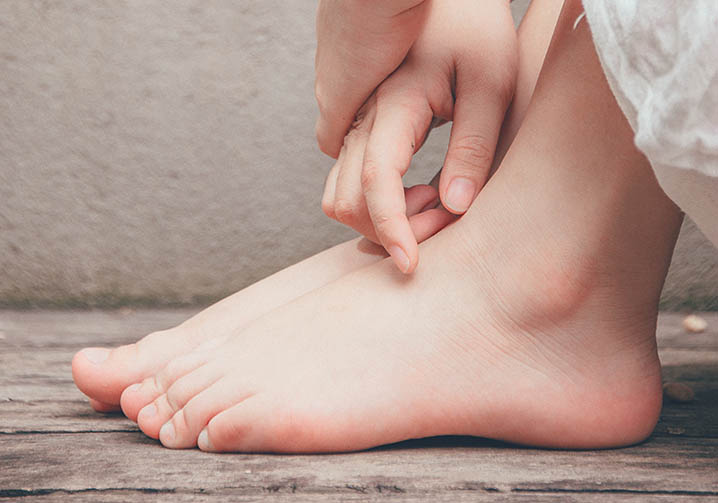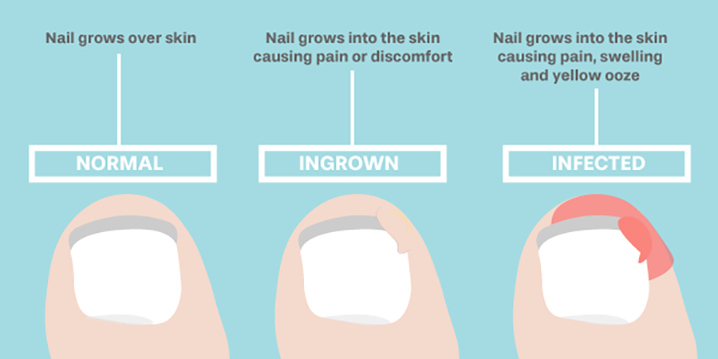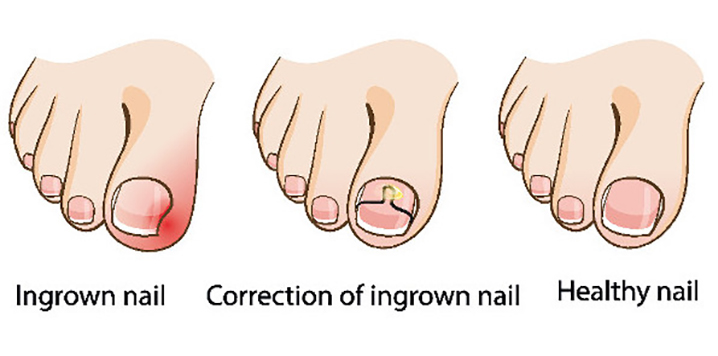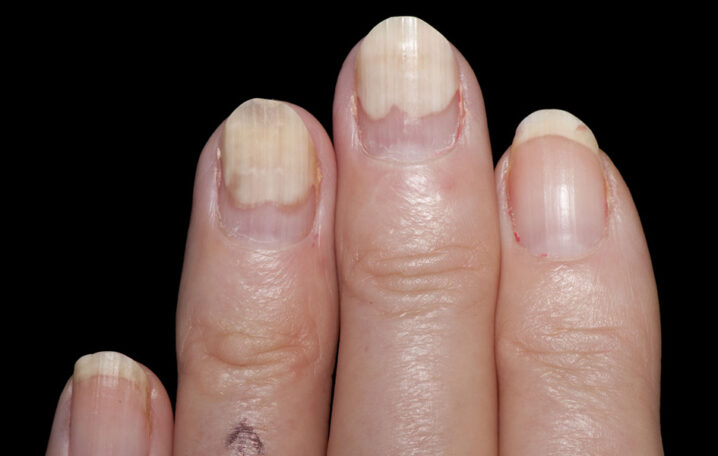Blog
How to Deal with Common Nail Problems: Ingrown Nails and Onycholysis

Most of us don’t think much about our nails unless we want to make them look good by painting them or getting nail art at our favorite nail salon but nails actually have an important role in our body. Aside from helping us with simple daily tasks like scratching, they serve as a hard surface that protects the tips of our fingers and toes. It also acts as a sign of impending ailments such as iron deficiency, hypovolemia or dehydration, to name a few.
But like any other part of our body, nails are also prone to issues which is why we also need to take care of them. In this article, we will talk about two of the most common issues: ingrown nails and onycholysis.
INGROWN NAILS

Source: Google Images
What are ingrown nails?
Ingrown nails are probably one of the most common and yet overlooked problems everyone encounters. It is caused by the simplest things such as the way you trim your nails, what type of shoes you wear and how you wear them or even hereditary issues. Any of the nails, even your fingernails, can develop it but most of the time it occurs in the big toe. Good thing it doesn’t happen often with fingernails because that would make basic tasks such as typing on your phone or laptop very uncomfortable!
Scientifically, it is called onychocryptosis or unguis incarnatus and it occurs when the skin on one or both sides of the nail grows over the edges of the nails or when edge of your nails digs or grows into the skin. The extreme curvature of the nails or involuted nails resulting from footwear, trauma or activities places pressure onto the toenails or damages the nail root which causes the nail to grow misshapen or thickened. Over time this can impact the shape and contour of the nail plate and creates pressure and pain where the nail has increased its curvature against the nail bed and groove. It is most common in adults, especially young adults in their 20s or 30s. It is also more common in men than in women.
There are three stages of ingrown nails. First, it will feel hard, swollen and tender. After some time, it might get red and feel sore. This redness, pain and swelling may soon result in an infection where a small amount of pus can be seen draining from the area.
What causes ingrown nails?
1. A common cause of ingrown nails is usually because of closed shoes which squeezes and compresses your toenails into the skin. This is why toes are most likely to get an ingrown nail.
2. If nails are not trimmed properly, it can also develop into ingrown nails. In line with this, nail-biting will most likely be a cause as well.
3. If you notice that several of your relatives and family members also suffer from constant ingrown nails, it might indicate that you have a genetic predisposition to ingrown toenails. Those who have naturally curved nails are more prone to having ingrown nails, too.
4. If you are the type who is very active, your nails might get damaged repetitively by either an acute injury near the nail making it to ingrown nails.
5. Other disorders such as fungal infections may be a reason because it can cause a thickened or widened toenail to develop.
How can we prevent ingrown nails?
It is advisable to keep your toenails at a moderate length, at least it should be even with the tips of your toes. If you trim it too short, it might grow into the skin. Trimming your toenails straight across is recommended. Most people trim their nails according to the shape of the toe but these may later grow into the skin.
Wearing appropriate footwear is one of the best ways to decrease the risk of ingrown toenails. Try to avoid shoes that put too much pressure on your toes or squeezes them. It might be hard to let go of those gorgeous heels that don’t really fit you well, but it is not worth the pain and hassle of having ingrown nails!
People with illnesses such as diabetes are more prone to ingrown nails, so the most you can do is to check it daily for signs and start special treatments. Otherwise, there are ways to treat ingrown nails in the comfort of your home.
How can we treat ingrown nails at home?
You should try to treat ingrown nails as soon as you identify them. If you found out you have ingrown nails early or before the infection sets in, you can do the following nonsurgical treatments at home:
1. Apply warm compress or soak the finger in warm, soapy water for ten to twenty minutes a day. Do this at least twice a day. This will help reduce swelling and relieve the tenderness. After soaking, you can put cotton under the ingrown edge to help the nail grow above the skin edge. Make sure to soak the cotton with antiseptic or disinfectant. Change the cotton everyday at the same time pushing it a little farther in to guide the nails. Repeat this on a daily basis while trying to use a bit more cotton each time. This process is known as packing.

Source: Google Images
2. Keep your them dry for the rest of the day
3. During the treatment period, it is best to wear comfortable shoes where there is enough space for your toes. Sandals, slippers or open-toed shoes are recommended.
4. You can do corrective filing by using a nail file to make the nails straight and leave a free edge. This allows the nail to grow and widen so the edges don’t dig into the skin.
5. Getting regular manicures and pedicures!
At Kiyosa Japanese Total Beauty we offer manicure and pedicure services!
When do we need to go to a doctor for ingrown nails?
Most people just treat ingrown nails at home, which is fine if it is only a mild issue. If the above non-surgical treatments doesn’t help improve your ingrown nail, it’s best to call for a doctor. A specialist for this is called a podiatrist.
If left untreated, the ingrown toenail can develop into an infection, or worse, an abscess that could require surgical treatments. Anytime an ingrown toenail has developed into an infection it is better to seek medical attention.
If an infection is present, the doctor can surgically remove a portion of the nail (called partial nail avulsion), a portion of the underlying nail bed, or some of the adjacent soft tissues. Surgeries are effective to remove the nail edge growing inward and cutting to the skin. Worst case scenario, a permanent removal might be needed for those who have recurring infections. The extent of the procedure will depend on the severity of the infection and if you have any other medical problems. It may take three to four months for the nail to completely regrow.
If you have diabetes or have an increased risk for infection it is best to see your doctor right away. Due to these types of illnesses, ingrown toenails may quickly come infected because of the lack of blood flow and nerve sensitivity.
What are other corrective techniques for preventing ingrown nails?
Beyond having surgeries, doctors may choose from a number of other corrective techniques to widen the nail and reduce the risk of ingrown nails.
1. One technique is to cut a “V” out of the center of the free edge. This removes the severe arch of the nail and the hope is that the nail will grow out flatter and wider.
2. Another technique is to drill a very small hole on each side of the nail and thread a piece of wire up one hole, across the nail and down through the other hole. Once the wire is tightened and secured, it forces the high arch of the nail to flatten, causing the edges of the nail to flair. Again, the theory is that over time, the nail will begin to naturally flatten and widen.
3. There is a technique called nail bracing where, as the name suggests, a small brace is used to lift up the nails. The process includes fastening of small medical grade wires across the nail surface and glued in place. This helps pull the nail out of the skin and as time goes by the nail should drastically improved. The aim is to correct the shape or the involution of the nails and decrease the formation of any hard skin or callous that usually forms due to the pressure from the nails. In some cases it can totally reduce the involution or inward curving of the toenail.

Source: Google Images
ONYCHOLYSIS
What is onycholysis?
You may already experience it and not even know that it is. Onycholysis is the term used when your nail plate is separated from the nail bed under it. The affected nail may change in color depending on the cause. Usually, it becomes yellow or white. This is usually not painful because the separation happens gradually. It may last for several months until new nail grows to replace the old one and it should get back to normal. For fingernails, it may take four to six months to fully regrow, while toenails may take eight to twelve months.

Source: Google Images
What causes onycholysis?
Similar to ingrown nails, the causes for onycholysis are injuries or trauma to the nail. Some examples are wearing tight shoes or even repetitive tapping or drumming of fingernails. It can also result when manicure tools are pushed beneath the nail to clear dirt or skin sensitivities to products such as glue, acrylics or acetone that are used during manicures and pedicures.
It can also be a symptom of underlying illnesses such as psoriasis, a thyroid condition, vitamin deficiency, fungus or yeast infections.
How can we treat onycholysis at home?
Once you have determined the cause of onycholysis, you can try to treat it at home if your case is not severe. Usually, the portion of the nail that is lifted will eventually correct itself as it grows. In the meantime, you need to prevent further damage to the nail and observe proper hygiene to prevent possible infection.
1. Nails should be cut to a comfortable length where they will be less likely to endure repeated trauma from tapping in everyday use.
2. Don’t try to clean underneath the nail because it may sweep the bacteria further in the nail bed.
3. Tea tree oil diluted with jojoba or coconut oil may help get rid of fungus. To prevent fungal infections, keep your nails dry.
4. Always wear rubber gloves when dealing with immersion in water such as laundry or washing dishes. Nails expand after they are exposed to moisture and then shrink while drying. This can contribute to brittle nails as well.
5. Avoid frequent exposure to harsh chemicals, particularly the ones used in salons. Make sure that the nail salon you go to uses quality and safe products.
6. Onycholysis usually does not need emergency medical appointment and if you take care of your nails, it will eventually reattach to the nail bed as it grows again. However, it is always better to consult a doctor about it especially if it is recurring as it might be a symptom of a serious illness.
Conclusion
As they say, prevention is better than cure! Start taking care of your nails and prevent these types of nail problems by practicing good hygiene.
It’s also helpful to getting a regular manicure or pedicure with your trusted nail salon. If you want convenience and less hassle, let professional nail technicians do it for you! KIYOSA Japanese Total Beauty salon in BGC offer Manicure and Pedicure starting at P850! Check out more of our hands and feet care services here.
For bookings and reservations, you may fill up the web reservation form or contact our BGC branch:
Mobile: 0939-915-8888
Phone: 8805-8888
Location: Ground Floor F1 Hotel 32nd Street Corner Lane Q, Bonifacio Global City, Taguig
Operating Hours: 11:00 AM – 8:00 PM

